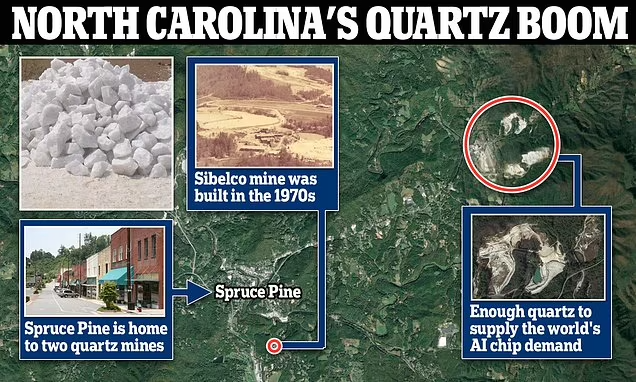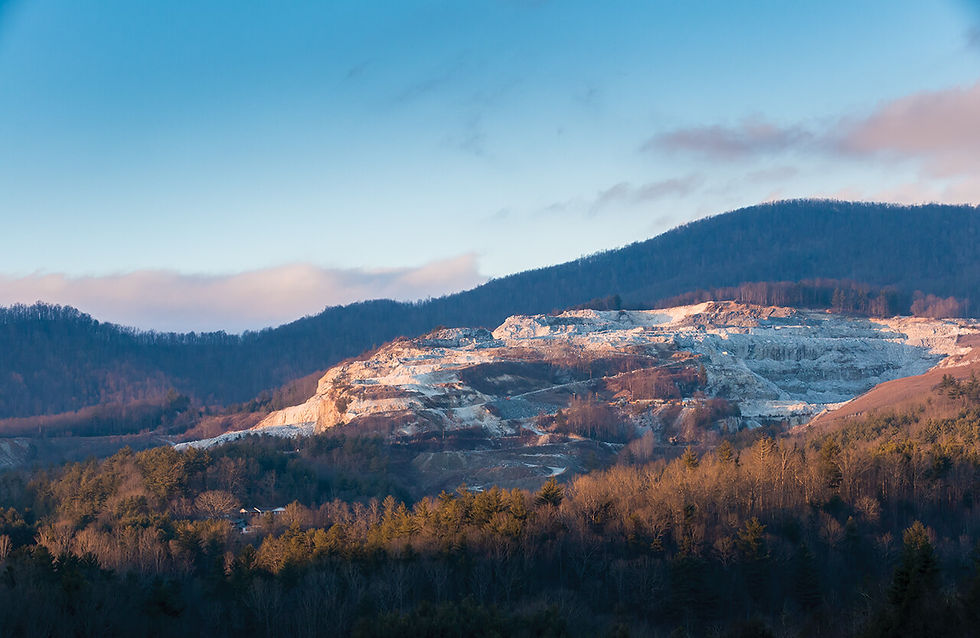

It’s easy to forget that even the most complex systems can sometimes depend on shockingly simple components. But what if I told you that the global economy rests—quite literally—on a single road in a small town in North Carolina? Well, it’s not fiction; it’s Spruce Pine, and recent events have made this unsettling reality impossible to ignore.
Spruce Pine, North Carolina, isn’t the sort of place that comes to mind when you think of technology hubs. But nestled within the Appalachian Mountains, this town is home to two critical mines that produce something most people don’t even know exists: ultra-high-purity quartz. Quartz may sound like a simple mineral, but for the tech industry, it’s gold dust. It’s the cornerstone material for making the crucibles used to refine silicon wafers, the building blocks for semiconductors. No quartz, no silicon wafers. And no silicon wafers? Well, say goodbye to the modern tech ecosystem—smartphones, computers, AI-driven devices, you name it.

Here’s where it gets even scarier: there are no known alternative sources for this type of quartz. If something disrupts Spruce Pine’s supply chain, the entire semiconductor industry could grind to a halt.
The Storm That Shook Silicon: Helene’s Wrath
Fast forward to this past weekend. Western North Carolina got hit hard by Tropical Storm Helene, and the damage was nothing short of catastrophic. Torrential rains triggered massive floods that washed away homes, submerged towns, and—critically—destroyed roads and bridges across the region, including the very roads leading to the quartz mines in Spruce Pine. Google Traffic data on Monday morning shows what everyone feared: the roads leading to the Sibelco mining facilities, one of the top producers of ultra-high-purity quartz, are closed. It’s Mollick’s nightmare scenario unfolding in real time.
A Fragile Supply Chain
Ethan Mollick, a Wharton professor who specializes in artificial intelligence and start-ups, made waves back in March when he took to X (formerly known as Twitter) to explain just how dependent the modern economy is on a single stretch of asphalt in North Carolina. “The road runs to the two mines that are the sole supplier of the quartz required to make the crucibles needed to refine silicon wafers,” Mollick explained, adding the gut-punch that “there are no alternative sources known.”
At the time, his claim seemed theoretical, maybe even hyperbolic. Now, with roads around the Sibelco mining facilities washed out and entire swaths of Western North Carolina cut off, it’s clear he was onto something far more real—and far more terrifying. In fact, the world got a glimpse of what this kind of disruption could look like back in 2008. A fire at one of the quartz facilities in Spruce Pine led to a supply halt that sent shockwaves through the tech world, according to a 2018 Wired article. That was just a fire; imagine what widespread flooding and road destruction could do.
Ripple Effect: What Happens if Quartz Supply is Cut Off?
It’s not just theoretical anymore—this is happening. While there’s been no official word yet from Sibelco or other mining companies about production delays or disruptions, the situation on the ground is dire. With roads washed out and no immediate relief in sight, it’s not hard to see how this could lead to a major bottleneck in quartz supply.
And that bottleneck wouldn’t just affect North Carolina; it would ripple through the entire global economy. Tom’s Hardware echoed Mollick’s concerns earlier this year, citing excerpts from James Conway’s book, Material World, which warned of the potential “end of computer chip manufacture as we know it” if anything went awry in Spruce Pine. Think about that for a moment: the smartphones in our pockets, the data centers powering the cloud, the AI systems we’re all increasingly relying on—it all could come to a grinding halt.
The tech industry is notoriously globalized. Silicon wafers might be refined in the U.S., but they’re manufactured into chips in places like Taiwan, South Korea, and Japan, and then shipped worldwide. A delay or disruption at the source—Spruce Pine—would have a domino effect, potentially halting production lines from Silicon Valley to Shenzhen.
This story is more than just a cautionary tale about the aftermath of a tropical storm. It’s a reminder of just how vulnerable modern supply chains are. We’re used to thinking of technology as a near-infinite resource, constantly getting smaller, faster, and cheaper. But what happens when that progress is tethered to something as fragile as a road in North Carolina?
We’ve already seen supply chain disruptions wreak havoc on everything from toilet paper to microchips during the pandemic. But this situation highlights an even deeper fragility—one that can’t easily be fixed by alternate routes or new suppliers. The quartz in Spruce Pine is uniquely pure, and there’s no backup plan, no alternative mine halfway around the world. It’s Spruce Pine or bust.

The real question now is: What happens next? Roads can be rebuilt, sure, but how long will that take? And what about the impact on tech manufacturers who rely on a steady stream of quartz to produce the semiconductors that drive everything from cars to AI supercomputers? While the rest of the world may be focusing on the floods and road closures, the tech industry is likely holding its breath, waiting to see if this disaster will cause a ripple effect in an already fragile semiconductor market.
In a world where we rely on artificial intelligence to help drive innovation, it’s a stark reminder that even the most cutting-edge advancements are often rooted in something as simple—and as vulnerable—as a road running to a mine in North Carolina.
And for now, that road is underwater.
Sources: Google Traffic Data, X (formerly Twitter) posts from Ethan Mollick, Wired, Tom’s Hardware, U.S. News.

コメント